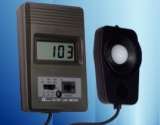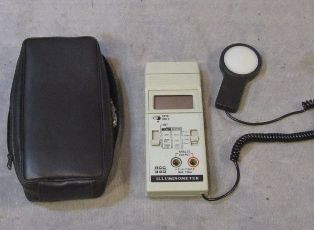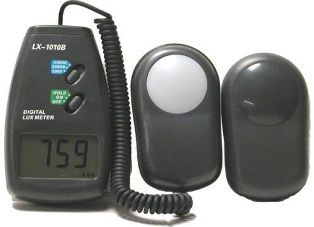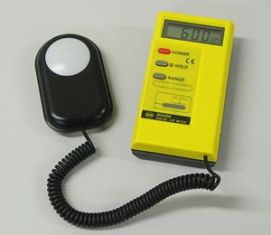Illumination measurement: theory and practice
 Why measure illuminance? It has been proven that bad (or vice versa, too good) light through the retina affects the working processes of the brain. And as a result, on the human condition. Insufficient lighting suppresses, efficiency decreases, drowsiness appears. Too bright light, on the contrary, excites, contributes to the connection of additional resources of the body, causing their increased wear.
Why measure illuminance? It has been proven that bad (or vice versa, too good) light through the retina affects the working processes of the brain. And as a result, on the human condition. Insufficient lighting suppresses, efficiency decreases, drowsiness appears. Too bright light, on the contrary, excites, contributes to the connection of additional resources of the body, causing their increased wear.
The measurement of the illumination of the workplaces is carried out together with the measurements of the level of noise, dust and pollution, vibrations — in accordance with SanPin (sanitary rules and norms). Doctors are sure that regular inadequate lighting causes fatigue, reduces visual acuity and reduces concentration. That is, there are all the prerequisites for an accident.
Bad light also affects other living things: plants, animals. It is a well-known fact that plants grow poorly without light. But insufficient lighting affects animals in the same way. Consequences: impaired growth and development, reduced productivity, poor weight gain, impaired reproduction.
What is lighting?
Illuminance is the value of the ratio of the luminous flux to the area on which it falls. Moreover, it must fall on this plane exactly perpendicularly. Measured in apartments, luxury. One lux is equal to the ratio of one lumen to one square meter of surface area. A lumen is a unit of measurement for light output. This is in the international units system. In England and America such units are used to measure illuminance as lumens per square foot. Or a footstool. This is the illumination from a light source of one candela at a distance of one foot from the surface.
In Europe, there is a standard for lighting workplaces. Here are some recommendations from him: lighting in an office where you don't have to look at small details should be around 300 lux. If the work process during the day is carried out on the computer or is related to reading, lighting of about 500 lux is recommended. The same lighting is expected in the meeting rooms. At least 750 lux in rooms where technical drawings are made or read.
Lighting can be natural or artificial. Sources of natural light are, of course, the sun, the moon (more precisely, the light of the sun reflected from it), the scattered light of the sky (such a poetic name is used even in the protocols for measuring illumination). Sources of artificial lighting are various types, shapes and designs, lamps and lamps, light from computer displays and mobile devices, television screens, etc.
Based on the name of the unit of illuminance (lux), the name of the device with which it is measured is a lux meter.It is a mobile, portable device for measuring illumination, the principle of operation of which is identical to a photometer.

A stream of light falling on the photocell releases a stream of electrons in the body of the semiconductor. Thanks to this, the photocell begins to conduct an electric current. Here, the value of this current is directly proportional to the illuminance of the photocell. It is reflected on the rock. In analog lux meters, the scale is calibrated in lux, the result is determined by the deflection of the needle.
Digital light meters are now replacing analog ones. In them, the result of the measurement is shown on the liquid crystal display. The measuring part in many of them is located in a separate case and is connected to the device with a flexible wire. This allows measurements in hard-to-reach places. Thanks to a set of light filters, the range of its measurements can be adjusted. In this case, the readings of the device must be multiplied by certain factors. The error of the lux meter, according to GOST, should be no more than 10%.

How is illuminance measured?
Using any methods to measure illumination is impossible without a lux meter. In addition, the rule is observed: the device is always in a horizontal position. It is installed in the necessary points. State standards contain schemes for the location of these points and methods for their calculation.
Until recently, GOST 24940-96 was used to measure illuminance in Russia. This is an interstate standard for measuring illuminance.This GOST uses concepts such as: illuminance, average, minimum and maximum illuminance, cylindrical illumination, natural illuminance coefficient (KEO), safety factor, relative spectral light efficiency of monochromatic radiation.
In 2012, Russia introduced its own national standard for illuminance measurement, GOST R 54944-2012. In this GOST, to the concepts that were previously added: emergency lighting, protective lighting, working lighting, backup lighting, semi-cylindrical lighting, evacuation lighting. Both GOSTs describe in detail the methods of measuring illuminance.
Measurements are made separately for artificial and natural lighting. At the same time, it is necessary to ensure that no shadow falls on the device and there is no source of electromagnetic radiation nearby. This will interfere with the results. After all the necessary illuminance measurements have been made, the necessary parameters are calculated based on the results obtained using special formulas and a general assessment is made. That is, the obtained parameters are compared with the standard and a conclusion is made whether the lighting of a given room or area is sufficient.
A separate protocol is filled out for each type of measurement in each room or section of the street. An assessment report is issued both for each room or area and for the entire facility. This is required by GOST. Measurement of illuminance "must be carried out according to the rules.
What kind of light is needed?
Research in this area shows that cold light reduces sleepiness and improves concentration. This is explained by the suppression of short waves (ultraviolet, blue) of melatonin.It is a hormone that regulates circadian rhythms. And if this light is also bright, it will help to cope with depression. The main thing is not to overdo it. And then from one extreme you can fall into another, get a sleep disorder. Cold light during the day should be moderate. And this is with enough lighting that will not force you to strain your eyes or, on the contrary, squint.
In the evening, on the contrary, dim light with warm colors is preferable. It promotes relaxation, good rest and bedtime. Avoid sharp and bright flashes, especially cold tones.
Of course, one-time violations of these rules will not cause serious health problems. But if this happens regularly, problems with body dysfunction cannot be avoided. Such a thing as light only seems trifle at first glance. It is necessary to periodically control it, measure the illumination.

